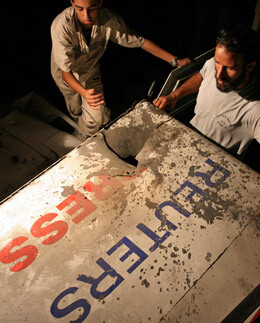Committee to Protect Journalists 28 August 2006

Palestinian journalists inspect a Reuters armored car after it was hit by an Israeli air strike in Gaza, 27 August 2006. (MaanImages/Wesam Saleh)
Reuters said the vehicle was clearly marked “Press” on all sides. The missile struck the letter “P” of the bright red “Press” sign on the car’s roof, the news agency added. Shana lost consciousness for several hours and suffered shrapnel wounds in his right hand and leg, Reuters reported. Hmaida sustained serious leg wounds from shrapnel.
Shana had rushed out to film a suspected Israeli air strike. He was about 1,300 yards (1,200 meters) from the nearest Israeli soldiers when the vehicle was struck, Reuters reported.
“We condemn this missile strike on a vehicle that was clearly identified as press,” said CPJ Executive Director Joel Simon. “The Israeli military must investigate this attack and hold those responsible accountable.”
An Israel Defense Force (IDF) spokesperson said the car had aroused suspicion because it was near soldiers in a combat area at night, Reuters reported. “This car was not identified by the army as a press vehicle,” army spokeswoman Capt. Noa Meir told Reuters. “If journalists were hurt, we regret it.”
The Foreign Press Association (FPA) in Israel called the attack an “outrageous targeting” and demanded a full investigation, adding, “there is a serious risk that relations between the FPA and the IDF will be significantly damaged.”
Other allegations of deliberate targeting of journalists covering fighting in Gaza and south Lebanon have been made against the Israeli army over the past two months. On July 27, Palestine Television cameraman Ibrahim al-Atla was seriously wounded by an Israeli tank shell during a lull in shooting between Palestinian militants and Israeli forces in Shijaiyah.
In Lebanon, crews from four Arab television stations told CPJ that Israeli aircraft fired missiles within 80 yards (75 meters) of them on July 22 to prevent them from covering the effects of Israel’s bombardment of the area around the town of Khiam, in the eastern sector of the Israel-Lebanon border.
Related Links